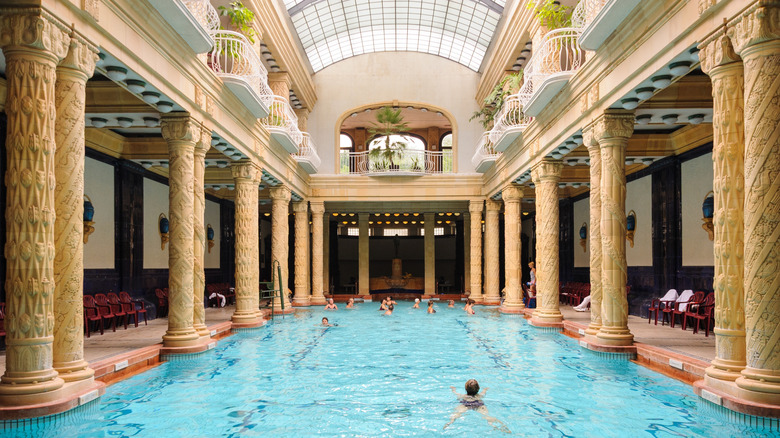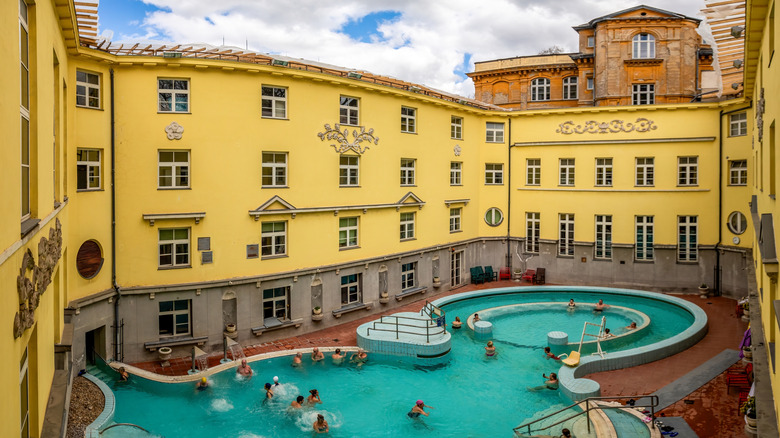Two Turkish Baths Rick Steves' Protégé Says Are Great Alternatives To Budapest's Most Popular Spots
Anyone who's ever been to the gloriously ornate capital of Hungary, Budapest, will tell you that the unmissable thing to do is head to one of the city's relaxing thermal baths. Bath houses were first established here by the Ottoman Turks in the 16th century during their occupation of the region, and today, there are nine medicinal baths in the city thanks to the 123 natural hot springs surrounding the banks of the River Danube.
Notoriously, the most popular baths are the Gellért, an Art Nouveau wonder, and the sprawling, picturesque Széchenyi Baths. But now's the time to swap these tourist favorites for some equally stunning, lesser-known counterparts. Travel expert Rick Steves' protégé Cameron Hewitt, longtime contributor to Steve's Budapest guidebook, highlights a few gems in a Facebook post: the Lukács and Veli Bej Turkish baths.
As Hewitt outlines, the Gellert just closed for refurbishment until 2028, and the Insta-famous Széchenyi is so packed with tourists that some of the pools feel like backpacker soup. Even if you think you've hacked the queue and nailed the best time to visit these Budapest baths at the crack of dawn, the Széchenyi still comes at a punchy price tag of around $40 for a basic entry ticket during the off-peak times. So Hewitt's suggestion of checking out the Lukács baths and Veli Bej is one heck of a travel tip to take heed of.
History and local appeal galore at the Lukács baths
A javelin's throw from Margaret Island, one of the best hidden gem destinations in Hungary, perched on the banks of the River Danube, the Lukács baths may be less grandiose than the Gellert, but they have an enjoyable air of ornate hospital about them. Before you step inside the doors at the Lukács, the healing effects of its waters are felt — the walls of the entrance courtyard are decorated with a tetris of Gratitude Tablets that date back as far as the 1890s, donated by those who were cured at this wellness resort over the centuries. A sure sign that you've come to the right place.
This health sanctuary has indoor and outdoor pools full of thermal medical waters varying in temperatures that visitors can rotate around. Known as contrast therapy these days (although it is a practice that dates back to Ancient Roman times), starting in warm water before heading to the hotter pool and then dunking in a cold bath is a fantastic way to reset your nervous system, ease muscle pain, and boost immunity as the process promotes swifter blood circulation. The Lukács is also home to a Himalayan Salt Room, where breathing in the salt-infused air helps ease respiratory issues. There is also a special pool known as the Weight Bath that treats back problems by gently stretching the spine while submerged in healing water. This spot is a firm favorite with local retirees, but it has yet to catch on with mass tourism, as Hewitt points out.
The majestic bliss of the Veli Bej Turkish baths
Right by the illustrious Margaret Bridge, the Veli Bej Turkish Baths, or Irgalmasok Veli Bej, are so hidden that you'd be forgiven for walking past them (or looping round the block a few times until you find the entrance). It's one of the oldest baths in the city and still has its original, grand 16th-century domed bath house, which was named after the Ottoman governor of the region at the time, Veli Bej. The only clue that a great octagonal bath awaits inside is the metal domes you can almost glimpse from outside, tucked inside the courtyard of a modern, refurbished building.
Once you've entered and got over the wow factor of the Turkish dome, we recommend floating in the temperate pool and gazing at the star-shaped vents in the ceiling. There are four smaller pools to try out around the corners of the large octagon — two hotter and two cooler. Again, this is a great place to try your hand at rotating around the different heats to reach the ultimate Budapest zen. Veli Bej also has a sauna, steam room, and jacuzzi just outside of the main domed building, so bring your sliders or crocs to avoid slipping while moving between them.
And to add the cherry on top of this domed haven, it's extremely reasonably priced to visit. The entry fees range between 4,500 HUF ($13) and 6,000 HUF ($18), depending on the time of day you pop along for a soak. These prices can also vary seasonally, but it is an ideal addition to your itinerary if you've headed to Budapest for an affordable winter vacation. So trust us, trust Cameron Hewitt, and trust the good folks of Hungary's capital by trying these lesser-known baths — you won't be sorry.


